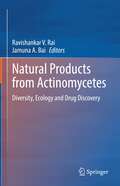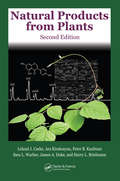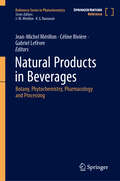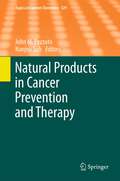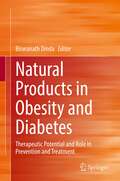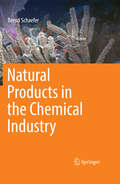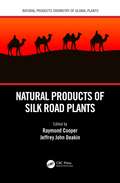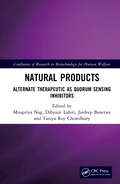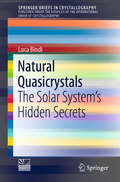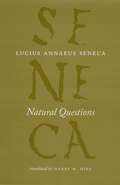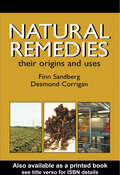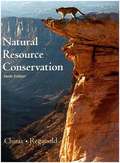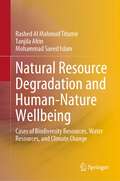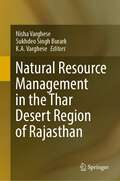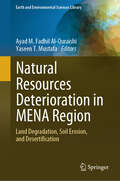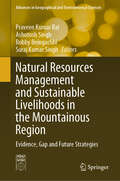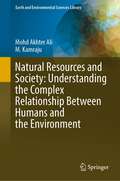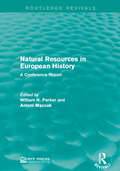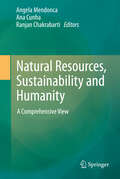- Table View
- List View
Natural Products from Actinomycetes: Diversity, Ecology and Drug Discovery
by Jamuna A. Bai Ravishankar V. RaiThis book provides in-depth information about the ecology, diversity and applications of Actinomycetes. The book is divided into two major parts. The first part discusses the diversity, chemical biology and ecology of Actinomycetes. It also covers the discovery of natural products from soil, endophytic and marine-derived Actinomycetes. It includes natural product discovery, chemical biology, new methods for discovering secondary metabolites, structure elucidation and biosynthetic research of natural products. The chapters in this part focus on the effects of biological and chemical elicitation at molecular level on secondary metabolism in Actinomycetes. The second part of the book discusses genomic and synthetic biology approaches in Actinomycetes drug discovery. This part includes chapters focused on the application of metabolic engineering to optimize natural product synthesis and the use of omics data in engineering of regulatory genes. It covers the advanced tools of synthetic biology and metabolic engineering including cluster assembly, CRISPR/Cas9 technologies, and chassis strain development for natural product overproduction in Actinomycetes. It describes the use of bioinformatics tools for reprogramming of biosynthetic pathways through polyketide synthase and non-ribosomal peptide synthetase engineering. These advanced genomic and molecular tools are expected to accelerate the discovery and development of new natural products from Actinomycetes with medicinal and other industrial applications. The book is useful to researchers and students in the field of microbiology, pharmaceutical sciences and drug discovery.
Natural Products from Plants
by Peter B. Kaufman Leland J. Cseke Ara Kirakosyan Sara Warber James A. Duke Harry L. Brielmann2008 NOMINEEThe Council on Botanical and Horticultural Libraries Annual Award for a Significant Work in Botanical or Horticultural Literature From medicinal, industrial, and culinary uses to cutting-edge laboratory techniques in modern research and plant conservation strategies, Natural Products from Plants
Natural Products in Beverages: Botany, Phytochemistry, Pharmacology and Processing (Reference Series in Phytochemistry)
by Jean-Michel Mérillon Céline Rivière Gabriel LefèvreThis reference book provides an overview of the active ingredients of selected plants present in beverages. The book aims to highlight according to the chapters the botanical, ethnobotanical, ecological or agronomic aspects of these botanical species used in some well-known or rarer beverages by linking them to their phytochemistry. This book also covers the manufacturing techniques, as well as the quality control of these products of natural origin in beverages. The content is divided into five main sections containing chapters written by valuable experts in their field : (1) beverages plants with caffeine and other methylxanthines, (2) beverage plants without caffeine, (3) fruits juices, (4) alcoholic beverage plants: non-distilled beverages and (5) alcoholic beverage plants: distilled beverages. The book is a useful resource for graduate students, academics and researchers in the field of botany, agriculture, food chemistry, nutrition as well as for industrial scientists and those involved in the commercialization of phytochemicals, plants and their extracts.
Natural Products in Cancer Prevention and Therapy
by John M. Pezzuto Nanjoo SuhChemoprevention of Esophageal Squamous Cell Carcinoma with Berries, by Gary D. Stoner and Li-Shu Wang Cancer Prevention by Different Forms of Tocopherols, by Chung S. Yang and Nanjoo Suh Cancer Chemopreventive and Therapeutic Potential of Guggulsterone, by Inas Almazari and Young-Joon Surh Inhibition of UVB-Induced Nonmelanoma Skin Cancer: A Path from Tea to Caffeine to Exercise to Decreased Tissue Fat, by Allan H. Conney, You-Rong Lou, Paul Nghiem, Jamie J. Bernard, George C. Wagner and Yao-Ping Lu Cancer Chemoprevention and Nutri-Epigenetics: State of the Art and Future Challenges, by Clarissa Gerhauser A Perspective on Dietary Phytochemicals and Cancer Chemoprevention: Oxidative Stress, Nrf2, and Epigenomics, by Zheng-Yuan Su, Limin Shu, Tin Oo Khor, Jong Hun Lee, Francisco Fuentes and Ah-Ng Tony Kong Keap1-Nrf2 Signaling: A Target for Cancer Prevention by Sulforaphane, by Thomas W. Kensler, Patricia A. Egner, Abena S. Agyeman, Kala Visvanathan, John D. Groopman, Jian-Guo Chen, Tao-Yang Chen, Jed W. Fahey and Paul Talalay Chemoprotection Against Cancer by Isothiocyanates: A Focus on the Animal Models and the Protective Mechanisms, by Albena T. Dinkova-Kostova Human Cancer Chemoprevention: Hurdles and Challenges, by Vaqar Mustafa Adhami and Hasan Mukhtar Personalizing Lung Cancer Prevention Through a Reverse Migration Strategy, by Kathryn A. Gold, Edward S. Kim, Ignacio I. Wistuba and Waun K. Hong Natural-Agent Mechanisms and Early-Phase Clinical Development, by Janet L. Wang, Kathryn A. Gold and Scott M. Lippman
Natural Products in Obesity and Diabetes: Therapeutic Potential and Role in Prevention and Treatment
by Biswanath DindaThis book provides a detailed summary of the therapeutic benefits of natural extracts from medicinal plants, mushrooms, algae, fungi and sponges and their role in the prevention and treatment of obesity and diabetes, offering readers a solid introduction to obesity and diabetes as well as current treatment models. In addition, it examines how genomics and multi-omics approaches have revolutionized our understanding of these diseases, and discusses the role of microbiome-host interactions, probiotics, prebiotics and the future of metabolic phenotyping.Focusing on the pharmacokinetics of anti-obesity and anti-diabetic phytochemicals, their bioavailability in the respective target tissues and their elimination times, the book also describes the nanoformulations of phytochemicals and herbal extracts. Lastly, it presents an overview of the advances in clinical studies on the use of herbal and mushroom extracts in obesity and diabetes management.Given its scope, this book is useful not only for researches in the field but also for students studying nutrition, food sciences, plant sciences or pharmacology, as well as for health professionals and practitioners.
Natural Products in the Chemical Industry
by Bernd SchaeferNatural Products in the Chemical Industry is not a conventional textbook, but rather an invitation to join an entertaining journey that takes you into the fascinating world of natural products. This book features diverse compound classes from a number of areas: colourants, fragrances and flavourings, amino acids, pharmaceuticals, hormones, vitamins and agrochemicals. Whether you are a teacher or a scholar, an undergraduate or graduate student, a professional chemist in industry or academia, or someone just interested in natural sciences, this book allows you to be inspired and entertained by facts and information along with enjoyable anecdotes, historical, economic, political, biological and social considerations. Experts in the field can have a pleasurable time cruising through captivating synthesis methods, which enable the generation of complex molecules on industrial scale. This book · deals with the manufacturing of larger quantities of complex molecules (asymmetric and heterocyclic compounds, polycyclic structures, macrocycles and small rings) · displays all reaction schemes in colour, which makes them easy to read · highlights aesthetics and elegance in modern industrial organic chemistry
Natural Products in the Chemical Industry
by Bernd SchaeferNatural Products in the Chemical Industry is not a conventional textbook, but rather an invitation to join an entertaining journey that takes you into the fascinating world of natural products. This book features diverse compound classes from a number of areas: colourants, fragrances and flavourings, amino acids, pharmaceuticals, hormones, vitamins and agrochemicals. Whether you are a teacher or a scholar, an undergraduate or graduate student, a professional chemist in industry or academia, or someone just interested in natural sciences, this book allows you to be inspired and entertained by facts and information along with enjoyable anecdotes, historical, economic, political, biological and social considerations. Experts in the field can have a pleasurable time cruising through captivating synthesis methods, which enable the generation of complex molecules on industrial scale.This book · deals with the manufacturing of larger quantities of complex molecules (asymmetric and heterocyclic compounds, polycyclic structures, macrocycles and small rings) · displays all reaction schemes in colour, which makes them easy to read · highlights aesthetics and elegance in modern industrial organic chemistry
Natural Products of Silk Road Plants (Natural Products Chemistry of Global Plants)
by Raymond Cooper Jeffrey John DeakinThe Silk Road, a complex network of trade routes linking China with the rest of the Eurasian continent by land and sea, fostered transformation of the ethnic, cultural, and religious identities of diverse peoples. In Natural Products of Silk Road Plants there is a treasury of plants, many indigenous to countries along the trading routes of the Silk Road, that yielded medicines, cereals, spices, beverages, dyes, and euphoric and exotic compounds previously unknown to the rest of the world. This entry in the Natural Products Chemistry of Global Plants series has been prepared for university students of chemistry and ethnobotany and for those wishing to broaden their knowledge. It opens a window on a vast region of Asia not well described for its flora and provides new and fresh insights on: Significant plants, some endangered Traditional and modern applications of extracts The biochemical and pharmacological properties of extracts Contains over 150 full colour figures The significance of the Silk Road is being revived today through immense investment by China and other eastern countries in major schemes of transport infrastructure.
Natural Products via Enzymatic Reactions
by Jörn PielKey Building Blocks via Enzyme-Mediated Synthesis, by Thomas Fischer and Jörg Pietruszka * Engineered Biosynthesis of Plant Polyketides: Structure-Based and Precursor-Directed Approach, by Ikuro Abe * Enzymatic and Chemo-Enzymatic Approaches Towards Natural and Non-Natural Alkaloids: Indoles, Isoquinolines, and Others, by Joachim Stöckigt, Zhong Chen, and Martin Ruppert * Chemoenzymatic and Bioenzymatic Synthesis of Carbohydrate Containing Natural Products, by Bohdan Ostash, Xiaohui Yan, Victor Fedorenko, and Andreas Bechthold * Total (Bio)Synthesis: Strategies of Nature and of Chemists, by Alexandra A. Roberts, Katherine S. Ryan, Bradley S. Moore, and Tobias A.M. Gulder
Natural Products: Alternate Therapeutic as Quorum Sensing (QS) Inhibitors (Confluence of Research in Biotechnology for Human Welfare)
by Moupriya Nag Dibyajit Lahiri Jaideep Banerjee Taniya Roy ChowdhuryMicrobial biofilm plays an important role in the life cycle of microorganisms surviving in diverse and harsh environments such as extremes of temperatures, pH, salinity, nutrient scarcity etc. Biofilm formation is a survival strategy adopted by microorganisms allowing colonization in new niches by dispersal of microbes from the microbial clusters embedded within an outer polymer layer produced by the microorganism itself. This layer comprises of extracellular polymeric substances (EPS) that helps the indwelling microbes to grow and divide in a protected environment against invaders like antimicrobial agents, surfactant, biocides and phagocytic cells of host organisms. Thus, EPS matrix prevents the penetration of antimicrobials thereby allowing the indwelling microbes to survive and give rise to antimicrobial resistance posing threat to human health. The present book highlights a detailed analysis of the mechanism of biofilm formation in both Gram positive and Gram-negative bacteria and the role of quorum sensing signaling mechanism in the genetic regulation pathway. The book titled "Natural Products: Alternative therapeutics as Quorum Sensing (QS) inhibitors" provides a detailed and systematic review of mechanism of quorum sensing in both Gram positive and Gram-negative bacteria and alternative pharmacological developments as a potent solution to the rise of antimicrobial resistance during biofilm formation. Features: A systematic overview of the mechanism of quorum sensing in the development of microbial biofilms Biofilm formation and its role in the emergence of antimicrobial resistance. Recent pharmacological development of antibiofilm remedies involving biogenic compounds. This book serves as a reference book for researchers investigating the progression of events during microbial biofilm formation starting from the genetic cascade regulating quorum sensing to secretion of autoinducers and design of safer methodologies for the successful eradication of microbial biofilm. It may also be used as a textbook for a undergraduate level course in microbiology or microbial biotechnology.
Natural Quasicrystals: The Solar System’s Hidden Secrets (SpringerBriefs in Crystallography)
by Luca BindiThis book describes the discovery of quasicrystals (icosahedral and decagonal) in an extraterrestrial rock from the Koryak Mountains of Far Eastern Russia. After a decade-long search for a natural quasicrystal, this discovery opened a new avenue in mineralogy and crystallography that could lead to further discoveries in geoscience, astronomy, condensed matter physics, and materials engineering. For the first time, minerals have been discovered that violate the symmetry restrictions of conventional crystallography. The natural occurrence of such crystals was unexpected, involving previously unknown processes. The fact that the quasicrystals were found in a meteorite formed in the earliest moments of the solar system means these processes have been active for over 4.5 billion years and have influenced the composition of the first objects to condense around the Sun. Finding quasicrystals formed in these extreme environments also informed the longstanding debate concerning the stability and robustness of quasicrystals. Recent shock experiments lend support to the hypothesis that the extraterrestrial quasicrystals formed as a result of hypervelocity impacts between objects in the early Solar system, and that they are probably less rare in the Milky Way.
Natural Questions
by Lucius Annaeus SenecaLucius Annaeus Seneca (4 BCE-65 CE) was a Roman Stoic philosopher, dramatist, statesman, and adviser to the emperor Nero, all during the Silver Age of Latin literature. The Complete Works of Lucius Annaeus Seneca is a fresh and compelling series of new English-language translations of his works in eight accessible volumes. Edited by world-renowned classicists Elizabeth Asmis, Shadi Bartsch, and Martha C. Nussbaum, this engaging collection restores Seneca--whose works have been highly praised by modern authors from Desiderius Erasmus to Ralph Waldo Emerson--to his rightful place among the classical writers most widely studied in the humanities. Written near the end of Seneca’s life, Natural Questions is a work in which Seneca expounds and comments on the natural sciences of his day--rivers and earthquakes, wind and snow, meteors and comets--offering us a valuable look at the ancient scientific mind at work. The modern reader will find fascinating insights into ancient philosophical and scientific approaches to the physical world and also vivid evocations of the grandeur, beauty, and terror of nature.
Natural Reflections: Human Cognition at the Nexus of Science and Religion
by Barbara Herrnstein SmithIn this important and original book, eminent scholar Barbara Herrnstein Smith describes, assesses, and reflects upon a set of contemporary intellectual projects involving science, religion, and human cognition. One, which Smith calls "the New Naturalism," is the effort to explain religion on the basis of cognitive science. Another, which she calls "the New Natural Theology," is the attempt to reconcile natural-scientific accounts of the world with traditional religious belief. These two projects, she suggests, are in many ways mirror images--or "natural reflections"--of each other. Examining these and related efforts from the perspective of a constructivist-pragmatist epistemology, Smith argues that crucial aspects of belief--religious and other--that remain elusive or invisible under dominant rationalist and computational models are illuminated by views of human cognition that stress its dynamic, embodied, and interactive features. She also demonstrates how constructivist understandings of the formation and stabilization of knowledge--scientific and other--alert us to similarities in the springs of science and religion that are elsewhere seen largely in terms of difference and contrast. InNatural Reflections,Smith develops a sophisticated approach to issues often framed only polemically. Recognizing science and religion as complex, distinct domains of human practice, she also insists on their significant historical connections and cognitive continuities and offers important new modes of engagement with each of them.
Natural Regulation of Animal Populations
by Ian A. McLarenSurveying an area dense with conflicting observations and ideas, this volume vividly depicts the current state of knowledge as well as the great diversity of opinion in the field of population ecology. Ten papers by outstanding authorities focus on three main issues-the effects of environment and population density on population dynamics, the influence of animal behavior on population growth, and the possibilities of genetic feedback or short-term evolutionary change on control of animal populations. An incisive introduction by the editor establishes a frame of reference and supplies succinct resolutions of some of the important controversies dealt with in these pages.
Natural Remedies: Their Origins and Uses
by Desmond Corrigan Finn SandbergThe past two decades have witnessed a phenomenal explosion of interest in the potential uses of plant medicines in healthcare and this has evoked the rebirth of pharmacognosy. This volume is unique in that it is the first, in English, to employ the Anatomical, Therapeutic and Chemical (ATC) classification system, developed by the World Health Organ
Natural Resource Conservation: Management For A Sustainable Future
by Daniel D. Chiras John P. ReganoldThis comprehensive text provides the ecological principles, policies, and practices to manage a sustainable future. It emphasizes practical, cost-effective, sustainable solutions to these problems that make sense from social, economic, and environmental perspectives.
Natural Resource Degradation and Human-Nature Wellbeing: Cases of Biodiversity Resources, Water Resources, and Climate Change
by Rashed Al Titumir Tanjila Afrin Mohammad Saeed IslamThe book addresses the gaps in the body of knowledge from two grounds. Firstly, it adds value through explaining the dynamics of natural resource governance by focusing on the particular arenas of biodiversity resources, water resources and climate change in developing country context. Secondly, it critically scrutinizes the market-centric perspectives on one hand and combines political economy questions that are generally overlooked in discussions of current resource governance framework, on the other. It develops a new framework to examine the reasons behind the degradations of natural resources to offer sustainable solutions to the problems. It shows that the natural resources have been exploited beyond sustainable limits due to the structural rigidities, embedded in, and reproduced by, fragile institutions and unequal power-sharing arrangements under the market-centric economic system. The book formulates a new understanding of sustainability in case of usage and management of natural resources by incorporating the idea of human sociality. It highlights the importance of the well-being of nature, and human beings must go side by side; one without the other is not a sustainable option. The book contains key learnings for scholars and researchers working in the field of development studies who wish to gain a deeper understanding on the sustainable natural resource governance specifically in the contexts of developing countries. For policymakers and policy advocates, the book serves as the groundwork on policies regarding biodiversity resources, water resources, and climate change, specific to the context of developing countries, providing more relevant contents in terms of laying out justification for policy objectives.
Natural Resource Management in the Thar Desert Region of Rajasthan
by Nisha Varghese Sukhdeo Singh Burark K. A. VargheseThis book covers a wide range of issues related to the Thar Desert Region of Rajasthan from an integrated and sustainable development perspective. The chapters in this book cover regional and local issues which are discussed with reference to the past scenario, the present practices, and the future strategies. Some of the issues addressed in this book like arid agroforestry, livelihood, and multidimensional development give it a cutting edge over other related publications currently available in the market. The chapters are supported with relevant pictures which will help the reader to connect with the issues being discussed. This book is useful to students, civil services aspirants, researchers, environmentalists, geographers, and non-professionals who are interested in deserts and desert development.
Natural Resources - Technology, Economics & Policy
by U. AswathanarayanaNatural resources management has two principal dimensions : Science-illuminated (earth, space, hydrological, pedological, information, etc. sciences) management of local resources (waters, soils, bioresources, minerals, rocks, sediments, etc.) in an ecologically-sustainable manner, and Value-addition through processing of natural products, through
Natural Resources Deterioration in MENA Region: Land Degradation, Soil Erosion, and Desertification (Earth and Environmental Sciences Library)
by Yaseen T. Mustafa Ayad M. Fadhil Al-QuraishiLand deterioration, drought, desertification, and water resources shrinkage threaten natural resources, negatively impacting environmental, economic, and political stability. The increasing occurrence of climate change (extremes) impacts land degradation processes, soil erosion by water and wind, and salinization. The researchers have invested several years of scientific research in natural resources deterioration, including soil degradation and erosion, land degradation, desertification, and climate changes, which are interesting enough. However, the link between science and policymaking appears to be less active as serious actions do not take fast. The eighteen chapters of this book focus more on topics related to natural resources deterioration, such as land degradation, desertification, drought, climate change, and analysis of numerous case studies. This book presents experts' overviews, study results, experiences, and knowledge of natural resources deterioration in MENA countries. It attracts researchers, experts, scholars, scientists, academics, students, practitioners, graduates, or anybody interested in land degradation, desertification, climate change, and natural hazards that fall within natural resources deterioration. Therefore, researchers keep continuing to do their investigations and produce results that convince stakeholders and policymaking to act immediately towards protecting natural resources and their sustainability.
Natural Resources Management and Sustainable Livelihoods in the Mountainous Region: Evidence, Gap and Future Strategies (Advances in Geographical and Environmental Sciences)
by Praveen Kumar Rai Ashutosh Singh Suraj Kumar Singh Bobby BeingachhiThis book explores the relationships between natural resources management, sustainable livelihoods, and integrated watershed management in the context of the mountainous region, especially in the northeastern region of India. The book also sheds light on the current state of regional issues, identifies gaps in the existing practices and proposes future policies for effective conservation and sustainable development.The environmental degradation in the northeastern region of India is basically attributed to the increasing biotic pressure on the fragile ecosystems in the absence of suitable investments and proper management practices to enhance and conserve the natural resources. Population growth and poverty on the one hand and the pressure of rising demand from wealth and consumerism on the other hand, have been exerting powerful pressure on the ecosystems. Natural resources planning and management and sustainable livelihoods through integrated watershed management is not just a technical challenge; it is also a social challenge. The book is a valuable resource for policymakers, researchers, practitioners and stakeholders involved in natural resource management, sustainable development and watershed management in the Himalayan region.
Natural Resources Systems
by Travis D. Park Tara L. BerescikNatural Resources Systems is a comprehensive text that features up-to-date coverage of today's natural resources management, including a focus on sustainability, global environmental issues, and the science behind the solutions to natural resources issues. It provides students with a basic introduction to many areas included in natural resources studies, including soil, air, water, endangered species, fisheries, game management, and cartography. Diverse conservation and natural resources management careers are highlighted in the Career Connection features throughout the text to provide students with examples of career paths taken by some of today's successful professionals. Special attention is given to the art of program, which includes pictures, charts, graphs, and illustrations, to education readers and help those who struggle with comprehension. Abundant STEM Connections, Environmental Features, and instructional features throughout the text help students learn by doing.
Natural Resources and Society: Understanding the Complex Relationship Between Humans and the Environment (Earth and Environmental Sciences Library)
by Mohd Akhter Ali M. Kamraju"Natural Resources and Society: Understanding the Complex Relationship Between Humans and the Environment" is a study of the dynamic interplay between humans and the natural world. The book explores the complex relationship between human societies and the environment, examining how human actions can both impact and be influenced by natural resources.The book covers a broad range of topics, including the history of human resource use, the role of natural resources in economic development, and the environmental impacts of resource extraction and consumption. It also considers the social and cultural factors that shape human interactions with the natural world, and the challenges of sustainable resource management. Overall, the book provides a comprehensive overview of the relationship between humans and the environment, emphasizing the importance of understanding this relationship in order to develop more sustainable and equitable societies.
Natural Resources in European History: A Conference Report (Routledge Revivals)
by Antoni Mączak and William N. ParkerNatural Resources in European History pulls together several papers from the Bellagio Conference on Natural Resources and Economic Development which took place in 1977. Originally published in 1978, this report focuses on papers exploring the history of natural resources in Continental Europe presenting research on how resources were traded, collected and depleted between the fifteenth and nineteenth century. This title will be of interest to students of Environmental Studies or with an interest in Environmental History.
Natural Resources, Sustainability and Humanity: A Comprehensive View
by Ana Cunha Angela Mendonca Ranjan ChakrabartiShortly, this book is the written up-graded version of the topics discussed during the Small Meeting of the 2nd International School Congress: Natural Resources, Sustainability and Humanity, held in Braga, Portugal, 5-8 May 2010 with the diverse participation of scientists, educators and governmental representatives. The Earth hosts an immense ecosystem, colonized by millions of species for billions of years but only for a few tens of thousands of years by humans. Environmental history tells though that it was humankind that shaped the environment as no other species. History, geography, religion and politics among other reasons have differentiated populations with respect to access to safe food and water, education, health, and to space and natural resource utilization. The globalization era of trade, information and communication is shortening distances and increasing overall wealth, but, as is pointed out in this book, it is also contributing to the propagation of diseases, and to the modification or even destruction of native ecosystems by exotic invasive species. Man is the only species that has the perception of its history, evolution, of the consequences of its decisions, and that there is a future ahead. It is also the only species that has the potential to change it. This awareness can be a source of anxiety and contradictory behaviours, but it is also the key to changing attitudes towards the construction of a common sustainable home, by committed education, interdisciplinary approaches, mobilization and empowerment of people and political consonant actions.
